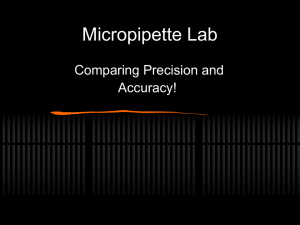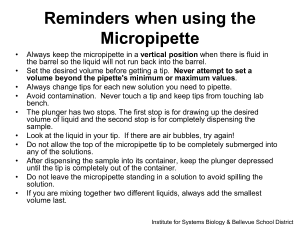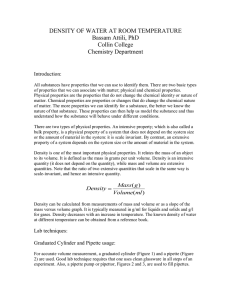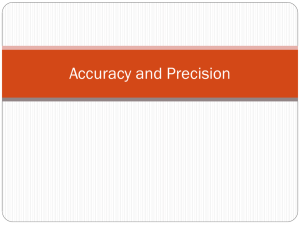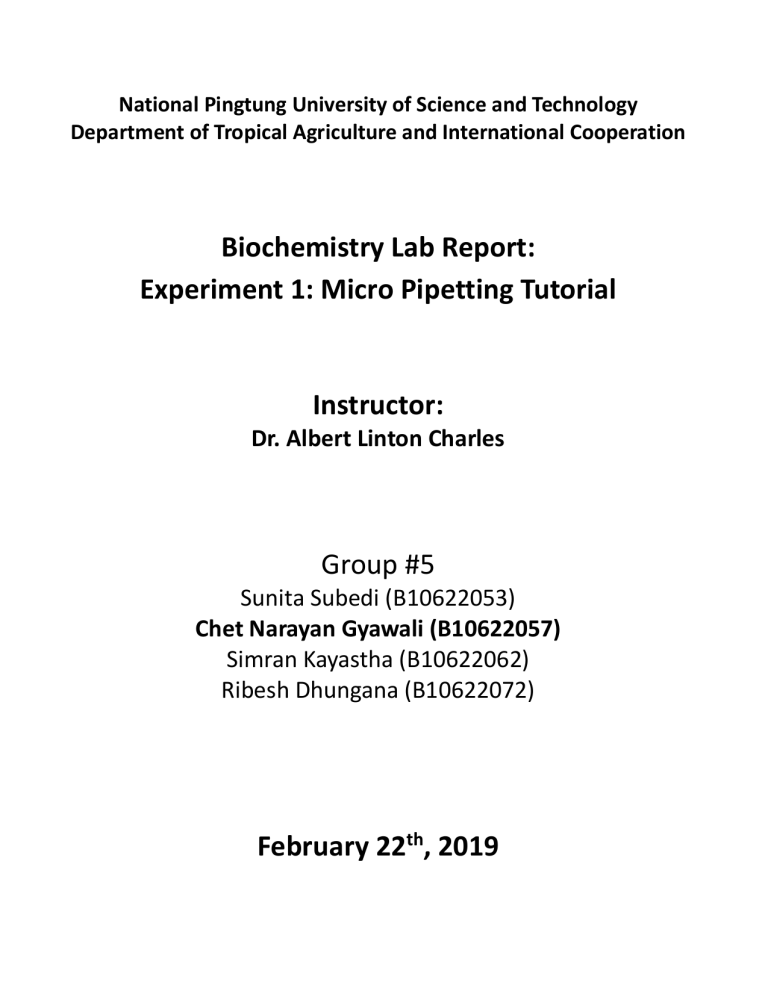
National Pingtung University of Science and Technology Department of Tropical Agriculture and International Cooperation Biochemistry Lab Report: Experiment 1: Micro Pipetting Tutorial Instructor: Dr. Albert Linton Charles Group #5 Sunita Subedi (B10622053) Chet Narayan Gyawali (B10622057) Simran Kayastha (B10622062) Ribesh Dhungana (B10622072) February 22th, 2019 Experiment 1: Micro Pipetting Tutorial 1. Introduction Classification and principles of micro pipette (pipette) first appeared in 1956, by the German Institute for Physiological Chemistry, scientists Schnittger invention, then, in 1958, Eppendorf, Germany began producing button-type micro pipette to become the world's first production of micro pipette company. Much of biochemistry, molecular biology involves working with very small volume. Typically, samples volumes and reagents are measured in microliters, or 1/1000 of a milliliter, which is abbreviated L. These small volumes are measured with a tool called a micropipette. Pipettes come in several designs for various purposes with different levels of accuracy and precision from single piece glass pipettes to more complex adjustable or electronic pipettes. In this experiment, we will learn how to use pipettors of various sizes and measure their accuracy, precision and calibration. 1.1 Pre-Lab Questions a) What is the usable range of a p- 1000 Eppendorf Pipetman? Ans: The usuable range of a P- 1000 eppendorf Pipetman is 200-1000l. b) What is the difference between accuracy and precision? Accuracy and precision both terms are applied to any experimental measurements. Accuracy is a measure of how close experimental measurements agree with known values. For example, we are attempting to measure two different volumes of water with our micropipette and two with our graduated pipet. Perfect accuracy would have us measure the exact volume we desire each time. However, the volume of water that we actually measure will be close but probably different from these volumes. The farther away from the correct volume, the lower the accuracy of our pipets and/or our technique will be. Precision is a measure of how close the experimental measurements agree with each other. The closer each measurement is to the other measurements, the more precise the measurements. For example, if the micropipette is set to the same volume (300 µL) and four measurements are taken at this volume, a standard deviation can be taken of these five measurements. The smaller the standard deviation, the more precise the micropipette is. c) What should 100l of water weigh? Ans: The weight of 100l water is 0.1 gram. 1.2 Principle A pipette tip constructed like a syringe is used. The pipette tip thus contains its own piston, which is operated by the pipette mechanism. Because of this unique mechanism, positive displacement systems are usually closed systems, that is, they cannot take tips from other systems. 2 1.3 Objectives The main objective of the lab experiment is to become familiar and adept at using micro pipettors and check the calibration of the pipettors. 2. Materials and Methods 2.1 Materials Equipment: a) b) c) d) e) 100- and 200- L pipettors 1000 L pipettors Yellow and white pipette tips Deionized water Weighing Balance Figure 1: Pipette 2.2 Methods A: Precision of P- 100 or P- 200 pipettor: At first, we acquired a P-100 and P-200 pipettor and with a correct size tip as shown in “Figure:2”. The pipette was set to 1000 L. The weighing cup was placed on the balance and tared the weight to zero. 100 L of deionized water was drawn into the weighing cup and dispensed it onto the weighing cup as shown in “Figure:3”. The weight of the water was recorded. The procedure repeated twice. We weighted 100 L for three times to measure accurate result up and compared the data. B: Precision of P- 1000 pipettor: At first, we acquired a P-100 and P-200 pipettor and with a correct size tip as shown in “Figure:2”. The pipette was set to 1000 L. then weighing boat was placed on the balance and tared the weight to zero. 1000 L of deionized water was drawn up and dispensed it onto the weighing boat as shown in “Figure:3”. The weight of water was recorded. The procedure was repeated more two times. Again, the pipettor was set to 100 L and the weight of the liquid was checked three times. 200, 500 and 750 L of water were drawn up just to see what they look like in the tip. The analysis of results questions was checked making sure that we have all the data needed the pipettors was adjusted to the highest volume size and the pipettors were put carefully away. 3 Figure 2: Inserting Tip in a pipettor Figure 3: Weight deionized water 3. Results and Discussion 3.1 Results A: precision of P-100 and P-200 pipettors a) The weight that we measured was recorded for the three trials of 100 l: Weight 1 (x1) = 0.10g Weight 2 (x2) = 0.10g Weight 3 (x3) = 0.10g b) The average of three trials is ∴ x1+x2+ x3 3 = 0.1=0.1=0.1 3 = 0.1g c) The % error between the average of the three trials and the true value was calculated: ∴ % error = | 𝑎𝑣𝑒𝑟𝑎𝑔𝑒 𝑤𝑒𝑖𝑔ℎ𝑡−0.1𝑔 0.1 0.1𝑔−0.1𝑔 | 0.1 | = =0 | × 100% × 100% d) The mean deviation for the three trials ∴ Mean deviation = ∑ | 𝑋𝑖−𝑋𝑎𝑣𝑔| 3 4 |0.1−0.1|+|0.1−0.1|+|0.1−0.1| = =0 3 B: Precision of P- 1000 pipettor a) The weight that we measured was recorded for the three trials of 1000 l Weight 1 (x1) = 0.99g Weight 2 (x2) = 1.00g Weight 3 (x3) = 1.00g b) The average of three trials is ∴ x1+x2+ x3 3 = 0.99+1.0+1.0 3 = 0.99g c) The % error between the average of the three trials and the true value was calculated: 𝑎𝑣𝑒𝑟𝑎𝑔𝑒 𝑤𝑒𝑖𝑔ℎ𝑡−1.00𝑔 | × 100% 1.00𝑔 0.99𝑔−1.0𝑔 =| | × 100% 1.00 ∴ % error = | = 1% d) The mean deviation for the three trials ∴ Mean deviation = = ∑ | 𝑋𝑖−𝑋𝑎𝑣𝑔| 3 |0.99−0.99|+|1.0−0.99|+|1.0−0.99| 3 0.02 = 3 = 0.006 C: the weight that measured for the three trials of 100 l using the P- 1000 was recorded. a) The weight that we measured was recorded for the three trials of 1000 l Weight 1 (x1) = 0.99g Weight 2 (x2) = 1.00g Weight 3 (x3) = 1.00g b) The average of three trials is ∴ c) x1+x2+ x3 3 = 0.10+0.10+0.10 3 = 0.10g The % error between the average of the three trials and the true value was calculated: 5 ∴ % error = | =| 𝑎𝑣𝑒𝑟𝑎𝑔𝑒 𝑤𝑒𝑖𝑔ℎ𝑡−1.00𝑔 1.00𝑔 | × 100% 0.10𝑔−1.0𝑔 | × 100% 0.10𝑔 =0% d) The mean deviation for the three trials ∴ Mean deviation = ∑ | 𝑋𝑖−𝑋𝑎𝑣𝑔| 3 |0.1−0.1|+|0.1−0.1|+|0.1−0.1| = =0 3 3.2 Discussion The micropipette is a reliable precision instrument that has been used to accurately measure small volumes of liquids (volumes typically vary from 5 to 1000 l) and trusted many years in biochemistry, molecular biology and other fields. Micropipette can deliver accurate and precise volume of solution. Accuracy is a measure of how close a measured value is to the accepted or “true” value. It is related to the percent error between the average volume of solution measured experimentally and the volume that was expected (the accepted value). Precision measures the closeness of a set of values obtained from identical measurements of the same quantity. It is the measure of reproducibility of a measurement (whether it’s accurate or not). The percent error between the average volume of solution and standard deviation are used to compare accuracy and precision respectively. In our experiment we use three types of micropipettes i.e. P-100, P- 200, and P-1000 l. We placed an appropriate tip on the end and push down gently plunger of the micropipette to suck the correct volume of water. When we push down the plunger of the pipette there would be vacuum created in the tip and water could drawn up. The volume to be taken up is set by turning the plunger on the top of the micropipette and reading the numerical settings displayed. A setting of 100 l is equal to 0.1 g. A setting of 1000 l is equal to 1.0g. Although micropipettes are usually quite accurate when first purchased, they can eventually develop problems with use so always need to put original position after use. 3.3 Post-Lab Questions 1. Which of the two pipettors that you used was the more accurate? Explain. Ans: From the result P-100 l pipette is more accurate. In 100 l the percentage error is zero whereas at P- 1000 l the percent error is 1% so P- 100 l is more accurate. 2. Which of the two pipettors that you used was the more precise? Explain. Ans: In our case, P- 1000 l pipette is more precise. The mean deviation for the three trials of P- 1000 is 0.006 6 and the percent error is 1%. Whereas at P- 100 l the mean deviation and percent error is zero. 3. Without checking the accuracy of a given Pipetman, would you predict that it is better to use a P-200 or P1000 to pipet 100 µL? Why? Ans: If longer pipette is used, then we might end up measuring an error and lack precision. Therefore, it will be better to use P-200 pipette to measure 100 µL and use P-100 to measure less than 100 µL. 4. Is a Pipetman more like a serological pipet or a Mohr pipet? Why? Ans: Pipetman is more like a serological pipet, as it expels the liquid completely out of it all the way to tip. 1. How do you make 200 mL of a 0.1M solution of a substance that has a molecular weight of 121.1 g/mol? Given, Volume of liquid (V) = 200 mL = 200\100= 0.2 L Molarity of solution (M) = 0.1 M Molecular weight (MW) = 121.1 g/mol Weight of solute (W) = X We know that, Molarity (M) = Number of moles / volumes of solution in L Or, molarity (M) = 𝑋 weight of solute in gram (W) MW×volume of solution in L Or, 0.1 M = 121.1×0.2 𝑋 Or, 0.1 M = 24.22 Or, X = 0.1 × 24.22 Therefore, X = 2.422 gm 4. Conclusions From this experiment, we were able to use micropipette and compare the precision and accuracy of the different kind of micropipettors. From the result, we concluded that the pipettor with shorter tubes could give more accurate results than longer tube. Micropipette needed an appropriate tip to suck the water up. Use of pipette is very essential in all of experiments, as the accuracy of the measurement of different liquid increases the more reliable the data will be. 5. References 1. Experiments in Biochemistry, 2019. Albert Linton Charles. National Pingtung University of Science and Technology. 2. Post lab No.3: https://www.chegg.com/homework-help/questions-and-answers/chapter-1-biochemistryboot-camp-33-34-37-4-without-checking-accuracy-given-pipetman-would-q23527957. Retrieved on February 25, 2019. 7
